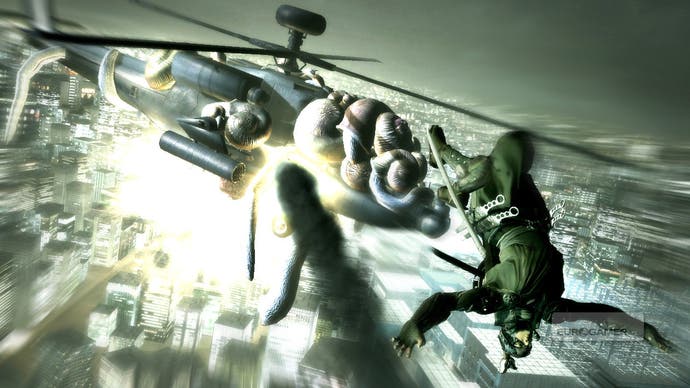Ninja Blade
The panto Ninja Gaiden.
In terms of actual proper grown-up videogaming interaction, the combat works with X and Y setting off your basic heavy or normal attacks, chaining in combos. By defeating opponents and the ever-nefarious crates, you discover - to use the proper gaming terminology - red blobs, which you can use to power up your weapons, opening up new, somewhat trickier attacks. Alternatively, you can use them on your various magical shuriken, which are used offensively (flame ones, for example - for hitting people, obviously), defensively (electricity ones, which form a shield that blocks incoming shots, for instance) or puzzle-solvingly (wind ones, which blow out fires, being one example). There are also two other ninja swords, which are basically heavy and light ones, also with puzzle-solving aspects (the heavy ones can bash open cracks in the walls, the light ones are on cords, so they can be used to propel yourself across gaps). And there's a block button too. That may sound like a lot to get a hang of at once, and it would be, which is why they're all introduced throughout the game.
Over on the platforming side, you can wall-run, swing on poles and run up walls, and do things like jumping between them. In other words, it's basic, but still enough for a few jumping puzzles, and doubly so when someone's impolite enough to shoot at you. There are also some extra-manoeuvrability elements, like being able to sprint over short, attack-dodging distances, or longer running. There's also Ninja Vision, which drains the same energy meter as your ranged attacks, and reveals which crates contain useful stuff and which bits of the wall are interactive, and slows down time for those who didn't get enough of that in FEAR 2.
And the rail shooter bits feature you shooting stuff on rails. That's all, folks. Move along.
It's mostly highly entertaining, if somewhat dumb. The problems come in the details and pacing. The combat is the most developed portion of the game, but still manages to fumble on some key aspects. Take the variety of moves, for example - when you upgrade, the higher-level attacks are so damaging you lean towards them as a matter of course. Some are so enormously powered you just end up spamming them - the heavy, area-effect air-attack, or the chain-attack at level three - to wipe out pretty much everyone. Since they're often activated by holding a trigger and attacking, you spend about a third of the game pretty much constantly holding one of the buttons, which seems like a lot of hand-cramp. The difficulty also spikes oddly, partly because some attacks really are much better than others, but often due to the idiosyncratic camera. On some boss fights especially, it often goes for a dramatic camera angle rather than something more practical.

To choose an example, the fight against some manner of space-crab-thing in the sewer is rendered trickier than it really should be by deciding to keep the space-crab-thing in shot the whole time, so it's tricky to work out whether you're about to deliver a justified pummelling to the evil leg or a justified pummelling to the air near the leg, or whether you're about to run into the leg and receive an unjustified pummeling. With the long cool-down after an attack, missing by a fraction is particularly annoying, as it means you can miss the crucial gap in an enemy attack pattern. The cool-down generally sticks in the craw. After throwing a ranged attack, your character stands around like a ninny, so dodging between attacks is harder than it should be. The Ninja Vision is another one - merging so many functions is a particularly bad call, especially when it marries its deactivation to blurring your vision for a crucial half-second afterwards. I was just trying to check which part of your lovingly rendered level was actually interactive - I didn't ask to be blinded.
Over on the platforming side, it's not very good. Specifically, the wall-jump is terrible. I'm not exactly sure why the game even lets you jump in a direction other than 90 degrees away from the surface you're running along, because as far as I could see there's not a place in the game where you have to do anything other than that. And since doing anything other than that sends you falling to insta-death, it's a little wince-worthy.
Then again, it's easy to be negative with Ninja Blade when you break it down in a reductive fashion, but that's not quite fair. Between the swearing-hard bits and the lulls, it's actually a lot of fun, much like hanging around with any true mentalist. When I read the back of the (Asian import) box, in its three-screenshotted features, it listed "Quick Time Events" as one. That raised an eyebrow. It's like listing "Ineffectual, infinitesimal penis" on a dating site. But Ninja Blade was right. It totally sold me on its ludicrous quick-time events, which have a lot of panache and... oh, I feel bad at even mentioning the demolition ball earlier in the review, but I had to choose one moment of proper "HE DID WHAT TO WHO WHAT?" to give you an example. My response to a lot of Ninja Blade was to laugh at it in the right way. As in, with it.








